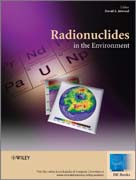
The global growth of the nuclear power industry will require a complete understanding of the impact of radionuclides in the environment. A great deal is known about the sources of radionuclides and their occurrence in the environment. However, the basic chemistry of these elements is a continually growing areaof research. There is no single resource for obtaining a holistic understanding of radionuclide environmental chemisty. The proposed book will provide thisresource with an element-specific coverage of the occurrence, chemistry, and speciation of environmental radionuclides written by experts in the area. The coverage for each element will be presented in a standard format, which will make it easier for the user to find all relevant information: 1. Occurrence 2. Chemistry and Speciation with regards to: a) soil (with adsorption or reactions on humic matter and mineral phases) b) water (may include biological uptake where this information is known) c) air (if applicable) 3. Separation Techniques 4. Analytical Characterization Techniques 5. Remediation (potential techniques or existing technologies) The 2nd Edition of the Encyclopedia of InorganicChemistry and the online version EIC did not cover the behavior of elements in the environment and the radioactive properties of the elements. This volume will therefore be an important addition to the Encyclopedia of Inorganic Chemistry.David Atwood Department of Chemistry University of Kentucky Lexington, KY 40506-0055 USA Tel: 001 859-257-7304 Fax: 001 859-323-1069 Email: Datwood@uky.eduDavid Allan Atwood was born in 1965 in Urbana Illinois. At an early age Davidmoved to Tuscaloosa Alabama where he grew up and ultimately attended college.After graduation from the University of Alabama he moved to Austin Texas to attend graduate school at the University of Texas with Richard Jones as his advisor. He graduated with his PhD (in Inorganic Chemistry) in the Spring of 1992but stayed in Austin as a postdoctoral associate with Alan Cowley until his wife, Vicki Ossink Atwood, finished her PhD (also in Inorganic Chemistry). FromUT he moved as an Assistant Professor to North Dakota State University as part of their new Center for Main Group Chemistry (of which he was co-director). In 1998 David Atwood joined the chemistry department at the University of Kentucky faculty as an Associate Professor. He now has over 160 publications, 10 patents, and serves on numerous editorial boards, including the Encyclopedia ofInorganic Chemistry, a 15 volume set published in Fall 2005. He is the founding editor and editor-in-chief of Main Group Chemistry. His research interests include detection and removal of heavy metal contaminants such as mercury, cadmium and lead, from the environment, the preparation of nanoparticulate metal oxides, prevention of aluminum alloy oxidation, and the synthesis of new Lewisacid compounds to effect new reactions, such as the breaking of phosphate esters bonds like those found in nerve gas agents and pesticides and the destruction of methyl-t-butyl ether (MTBE) a widespread water contaminant.
- ISBN: 978-0-470-71434-8
- Editorial: Wiley
- Encuadernacion: Cartoné
- Páginas: 508
- Fecha Publicación: 21/05/2010
- Nº Volúmenes: 1
- Idioma: Inglés
